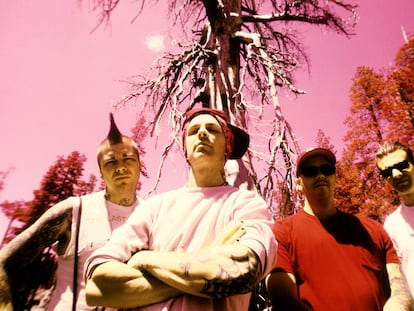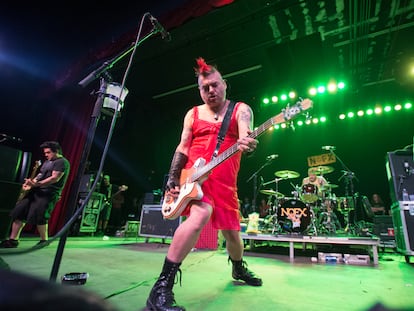Wild nights, wilder mornings at New York’s CBGB music venue
The documentary ‘At the Matinée’ depicts what went on during the day in and around New York’s punk mecca

The 1980s underground punk movement cannot be adequately understood without touching on a New York nightclub called the CBGB where the punk scene was rocking and New Wave was being born; performers like the Ramones, Patti Smith, Talking Heads, Television, and Blondie all made their debut there. The nights were theirs. Less known is what happened during the day when the most punk of punk, the most underground of the underground, the alternative to the alternative had its moment. Daylight hours was when the hardcore came out to play. Louder, and more furious.
The documentary streamed on the Filmin platform, At the Matinée, by Italian director Giangiacomo de Stefano tracks the antics at the CBGB of the so-called New York Hardcore or NYHC, which included names far less famous than those previously mentioned, though some did make a go of it and even did European tours; bands such as Gorilla Biscuits, Youth of Today, Agnostic Front, Murphy’s Law and Cause of Alarm. These groups were either formed in squats or lived in squats.
The CBGB could hold 300 people, and there were at least as many again hanging out on the street, talking about music and life in general. Inside, with the decibels blasting, the audience jumped about, pushing and shoving, getting up onto the stage and spitting beer at the bands and vice versa. The temperature rose to 40 °C and condensed sweat dripped from the ceiling. It was a party filled with rage and rebellion, but some say there was a ritual of solidarity about throwing yourself into the crowd knowing you would be caught.
As the 1980s went on, new urban tribes took over, such as the skinheads and straight edge — the latter representing an almost puritanical sect within punk that rejected the nihilistic hedonism and also the drugs and alcohol. Veganism would later be incorporated into their philosophy. You could pick them out by the image of an X on the back of their hand, the same X that is stamped onto those too young to be served alcohol. Some of the other hardcore bands moves across to straight edge. Others, shifted astutely to the more lucrative heavy metal genre.
CBGB Sunday Hardcore Matinee, 1984.
— Punkrock History (@PunkRockStory) March 19, 2023
Photos by Drew Carolan#punk #punks #punkrock #hardcorepunk #cbgb #history #punkrockhistory pic.twitter.com/5wbsvI6nvv
The documentary shows how Walter Schreifels, a member of Youth of Today and Gorilla Biscuits, made chillout versions of the most hallowed punk anthems, which of course were far removed from their origins. It also reveals that even the most ferocious hardcore punks — who were, indeed, mostly guys — admitted they were scared leaving the venue on the Lower East Side, which at that time was mainly populated by beggars, prostitutes, dealers, and junkies.
Nostalgia is powerful. The survivors of this era who were interviewed complain about the subsequent gentrification of the neighborhood, the rocketing house prices, the disappearance of the small shops, the lack of personality in the city due to big brand names. Above all, they miss the matinée mood at the CBGB.
Sign up for our weekly newsletter to get more English-language news coverage from EL PAÍS USA Edition
Tu suscripción se está usando en otro dispositivo
¿Quieres añadir otro usuario a tu suscripción?
Si continúas leyendo en este dispositivo, no se podrá leer en el otro.
FlechaTu suscripción se está usando en otro dispositivo y solo puedes acceder a EL PAÍS desde un dispositivo a la vez.
Si quieres compartir tu cuenta, cambia tu suscripción a la modalidad Premium, así podrás añadir otro usuario. Cada uno accederá con su propia cuenta de email, lo que os permitirá personalizar vuestra experiencia en EL PAÍS.
¿Tienes una suscripción de empresa? Accede aquí para contratar más cuentas.
En el caso de no saber quién está usando tu cuenta, te recomendamos cambiar tu contraseña aquí.
Si decides continuar compartiendo tu cuenta, este mensaje se mostrará en tu dispositivo y en el de la otra persona que está usando tu cuenta de forma indefinida, afectando a tu experiencia de lectura. Puedes consultar aquí los términos y condiciones de la suscripción digital.
More information
Archived In
Últimas noticias
Most viewed
- Sinaloa Cartel war is taking its toll on Los Chapitos
- Oona Chaplin: ‘I told James Cameron that I was living in a treehouse and starting a permaculture project with a friend’
- Reinhard Genzel, Nobel laureate in physics: ‘One-minute videos will never give you the truth’
- Why the price of coffee has skyrocketed: from Brazilian plantations to specialty coffee houses
- Silver prices are going crazy: This is what’s fueling the rally











































